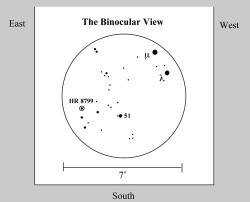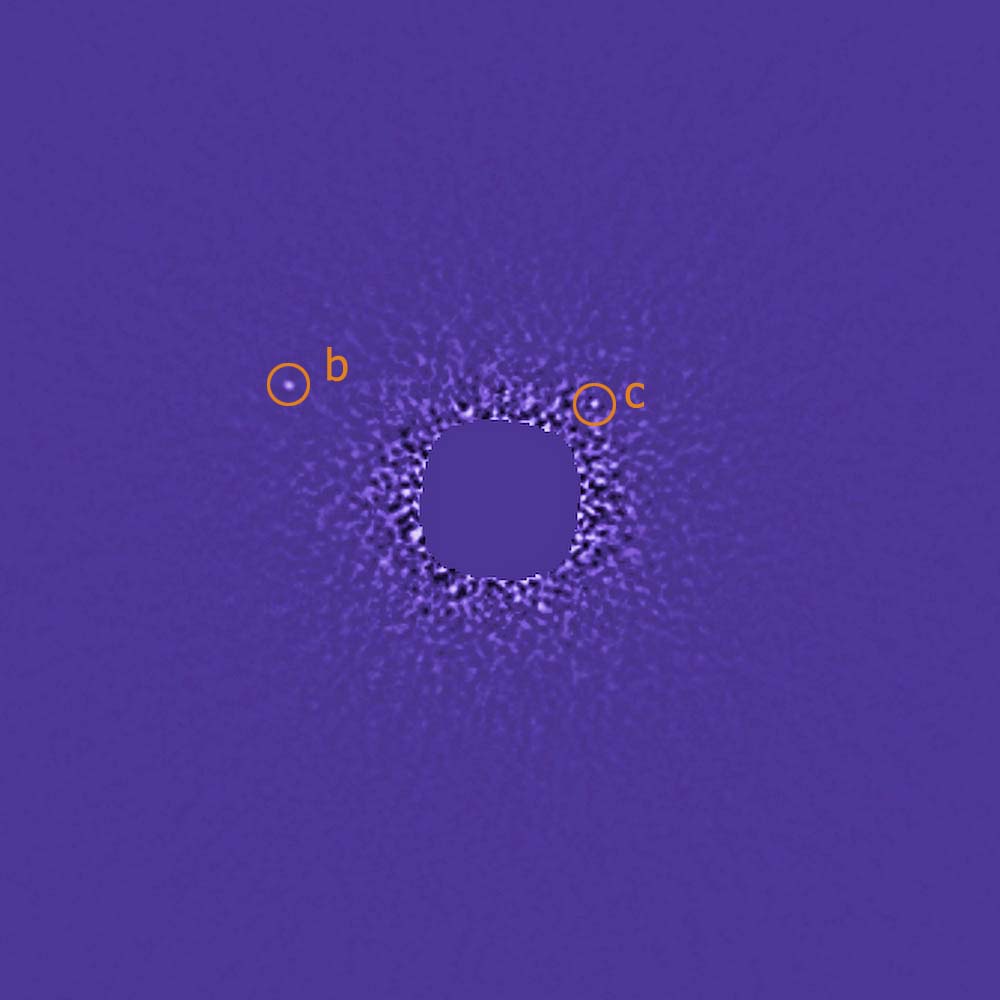Here’s what we’ve all been waiting for: for the first time, astronomers have taken pictures of a multi-planet solar system, much like ours, orbiting another star. This coincides with announcement of the first visible light image of an extrasolar planet taken by the Hubble Space Telescope. This new solar system orbits a dusty young star named HR8799, which is 140 light years away and about 1.5 times the size of our sun. Three planets, roughly 10, 10 and 7 times the mass of Jupiter, orbit the star. The size of the planets decreases with distance from the parent star, much like the giant planets do in our system. And there may be more planets out there, but scientists say they just haven’t seen them yet.
“We’ve been trying to image planets for eight years with no luck and now we have pictures of three planets at once,” said Bruce Macintosh, an astrophysicist from Lawrence Livermore National Laboratory.
Using high-contrast, near-infrared adaptive optics observations with the Keck and Gemini telescopes, the team of researchers were able to see three orbiting planetary companions to HR8799.
Astronomers have known for a decade through indirect techniques that the sun was not the only star with orbiting planets.
“But we finally have an actual image of an entire system,” Macintosh said. “This is a milestone in the search and characterization of planetary systems around stars.”

The planets are 24, 37 and 67 times the Earth-sun separation from the host star. The furthest planet in the new system orbits just inside a disk of dusty debris, similar to that produced by the comets of the Kuiper belt of our solar system (just beyond the orbit of Neptune at 30 times Earth-sun distance).
“HR8799’s dust disk stands out as one of the most massive in orbit around any star within 300 light years of Earth” said UCLA’s Ben Zuckerman.

The host star is known as a bright, blue A-type star. These types of stars are usually ignored in ground and space-based direct imaging surveys since they offer a less favorable contrast between a bright star and a faint planet. But they do have an advantage over our sun: Early in their life, they can retain heavy disks of planet-making material and therefore form more massive planets at wider separations that are easier to detect. In the recent study, the star also is young – less than 100 million years old – which means its planets are still glowing with heat from their formation.
“Seeing these planets directly – separating their light from the star – lets us study them as individuals, and use spectroscopy to study their properties, like temperature or composition,” Macintosh said.
During the past 10 years, various planet detection techniques have been used to find more than 200 exoplanets. But these methods all have limitations. Most infer the existence of a planet through its
influence on the star that it orbits, but don’t actually tell scientists anything about the planet other than its mass and orbit. Second, the techniques are all limited to small to moderate planet-star separation, usually less than about 5 astronomical units.
The planets themselves each appear very interesting.
“Detailed comparison with theoretical model atmospheres confirms that all three planets possess complex atmospheres with dusty clouds partially trapping and re-radiating the escaping heat” said Lowell Observatory astronomer Travis Barman.
Source: Gemini Observatory


Yet another image that I never expected to see! Fantastic work, folks, congratulations!
Regards, John M.
Woot! They are the most beautiful extrasolar planets I have ever seen.
Ther’s just one word for these two breaktrhoughs, this one and the one in visible light:
WOW!
We should name these after Obama and his family.
Wow… it’s a great day to be alive.
Yes!! Lets name planets after someone who was elected president, but has done nothing else except spend other peoples money!!
With as many politicians as we have had, we should be able to almost name the whole galaxy!
What a great discovery !!!
Congratulations !
Excellent!
Can’t wait until we get to see Pluto!
I am so fortunate to be a young and aspiring astronomer in these days! Congrats on this monumental finding!!!!
Great work by the team!
But was a bit suprised by this statement which is misleading:
Most infer the existence of a planet through its
influence on the star that it orbits, but don’t actually tell scientists anything about the planet other than its mass and orbit.
I guess it makes one to assume that we dont know anything other the mass and orbit while we have studied in detail the atmospheric profile of a few planets(eg. HD 209458b, HD 189733b)…
Just wanted to clarify this point..
They are not planets by definition. One of the main characteristics of a planet is they orbit the SUN (Sol). They don’t, therefore they are not planets. Yes I know this is picky, but if they’re going to call Pluto something else based on these criteria then these orbiting masses are not planets or extrasolar anything. Extrasolar has Sol right in the word and is used in reference to the SUN, no another star.
I thought that was a picture of an egg surrounded by sperm…
James Hartley thanks for you absolutely pointless comment
@Vino, I think for astronomers, obtaining high quality spectra (and other measurements e.g. apparent magnitude) could be more easily and precisely made with directly imaged planets as compared with transiting exoplanets. No doubt, these specific observations will still be difficult to make, but considerations involving stellar-planetary extrapolations and disentanglement of star-planet parameters would be greatly reduced by observing these bodies directly. Much about exoplanets can still be gleaned from planetary transit systems, but direct observations of new planetary bodies seems to me to be the way to go.
urgh! this is obviously a hoax. i could have whipped these images up with MSpaint myself in less than an hour.
You’re a moron Keen-Eye. This is now going to become among the most heavily studied regions in the whole sky, and any idiot would know that they would be found out in two seconds if they made it up. That comment wins you ‘moronic comment of the year’ award in my book.
haha paint brush? absolutely…
you could at least have said photoshop haha…anyways I guess you are the one that uncovered the hoax of the century huh? haha
I believe this is a very signifigant discovery because it shows a dust cloud around a star with planets, i believe that any star that can contain life as we know it must have this dust cloud or something very similar ,as it would protect against interstellar radiation and allows for microbial life to expand, the fact that this is a blue star is signifigant fact also, i do not know much about blue stars, but i understand that yellow stars give off a kind of light we need as Humans need to survive, any form of life on these planets would be vastly different to anything we can imagine, also these planets are very large, probably we could never visit them even if we could someday get there because we could not even stand up on 1 of these planets, however as our technology develops we may find more Worlds in this system more sympathetic to Human survival.
What is crazy with that news?
The u.s. hegemony on information…
Nowhere on the site(coming from B.C.?) it is said that the lead author of this article published in the last Science (08-11-13) is Christian Marois, an astronomer from Montréal now working at the Astrophysic Herzberg Institute of Victoria, B.C. Canada.
To whom want to get info from the author
http://www.sciencemag.org/content/vol0/issue2008/images/data/1166585/DC2/1166585.mp3
Pierre Poulin, Montréal, Québec
Congratulations from Scotland ‘s clan chattan to Bruce Macintosh and all the others involved in this historic endeavour. Well done!
bobobo
your welcome, but by definition they’re not planets, they’re rocks
Any chance of giving us RA Dec for these stars and other objects in these articles in future. I know we can’t see the exoplanets or pulsars etc with back yard scopes, but just know where they are in the sky…as say, “there, that’s where it is.”
Martin
How come there’s no “a” shown, just “b” and “c”?
I don’t understand any of this and don’t emal me back!!!!!!!!!!!!!!!
Great can’t wait to see pluto!!!!!!!!!!!!!!!!!!!!!!!!!!!!!!!!!!!!!!!!!!!!!!!!!!!!!!!!!!!!!!!!!!!!!!!!!!!!!!!!!!!!!!!!!!!!!!!!!!!!!!!!!!!!!!!!!!!!!!!!!!!!!!!!!!!!!!!!!!!!!!!!!!!!!!!!!!!!!!!!!!!!!!!!!!!!!!!!!!!!!!!!!!!!!!!!!!!!!!!!!!!!!!!!!!!!!!!!!!!!!!!!!!!!!!!!!!!!!!!!!!!!!!!!!!!!!!!!!!!!!!!!!!!!!!!!!
WOW!!!!!!!!!!!!!!!!!!!!!!!!!!!!!!!!!!!!!!!!!!!!!!!!!!!!!!!!!!!!!!!!!!!!!!!!!!!!!!!!!!!!!!!!!!!!!!!!!!!!!!!!!!!!!!!!!!!!!!!!!!!!!!!!!!!!!!!!!!!!!!!!!!!!!!!!!!!!!!!!!!!!!!!!!!!!!!!!!!!!!!!!!!!!!!!!!!!!!!!!!!!!!!!!!!!!!!!!!!!!!!!!!!!!!!!!!!!!!!!!!!!!!!!!!!!!!!!!!!!!!!!!!!!!!!!!!!!!!!!!!!!!!!!!!!!!!!!!!!!!!!!!!!!!!!!!!!!!!!!!!!!!!!!!!!!!!!!!!!!!!!!!!!!!!!!!!!!!!!!!!!!!!!!!!!!!!!!!!!!!!!!!!!!!!!!!!!!!!!!!!!!!!!!!!!!!!!!!!!!!!!!!!!!!!!!!!!!!!!!!!!!!!!!!!!!!!!!!!!!!!!!!!!!!!!!!!!!!!!!!!!!!!!!!!!!!!!!!!!!!!!!!!!!!!!!!!!!!!!!!!!!!!!!!!!!!!!!!!!!!!!!!!!!!!!!!!!!!!!!!!!!!!!!!!!!!!!!!!!!!!!!!!!!!!!!!!!!!!!!!!!!!!!!!!!!!!!!!!!!!!!!!!!!!!!!!!!!!!!!!!!!!!!!!!!!!!!!!!!!!!!!!!!!!!!!!!!!!!!!!!!!!!!!!!!!!!!!!!!!!!!!!!!!!!!!!!!!!!!!!!!!!!!!!!!!!!!!!!!!!!!!!!!!!!!!!!!!!!!!!!!!!!!!!!!!!!!!!!!!!!!!!!!!!!!!!!!!!!!!!!!!!!!!!!!!!!!!!!!!!!!!!!!!!!!!!!!!!!!!!!!!!!!!!!!!!!!!!!!!!!!!!!!!!!!!!!!!!!!!!!!!!!!!!!!!!!!!!!!!!!!!